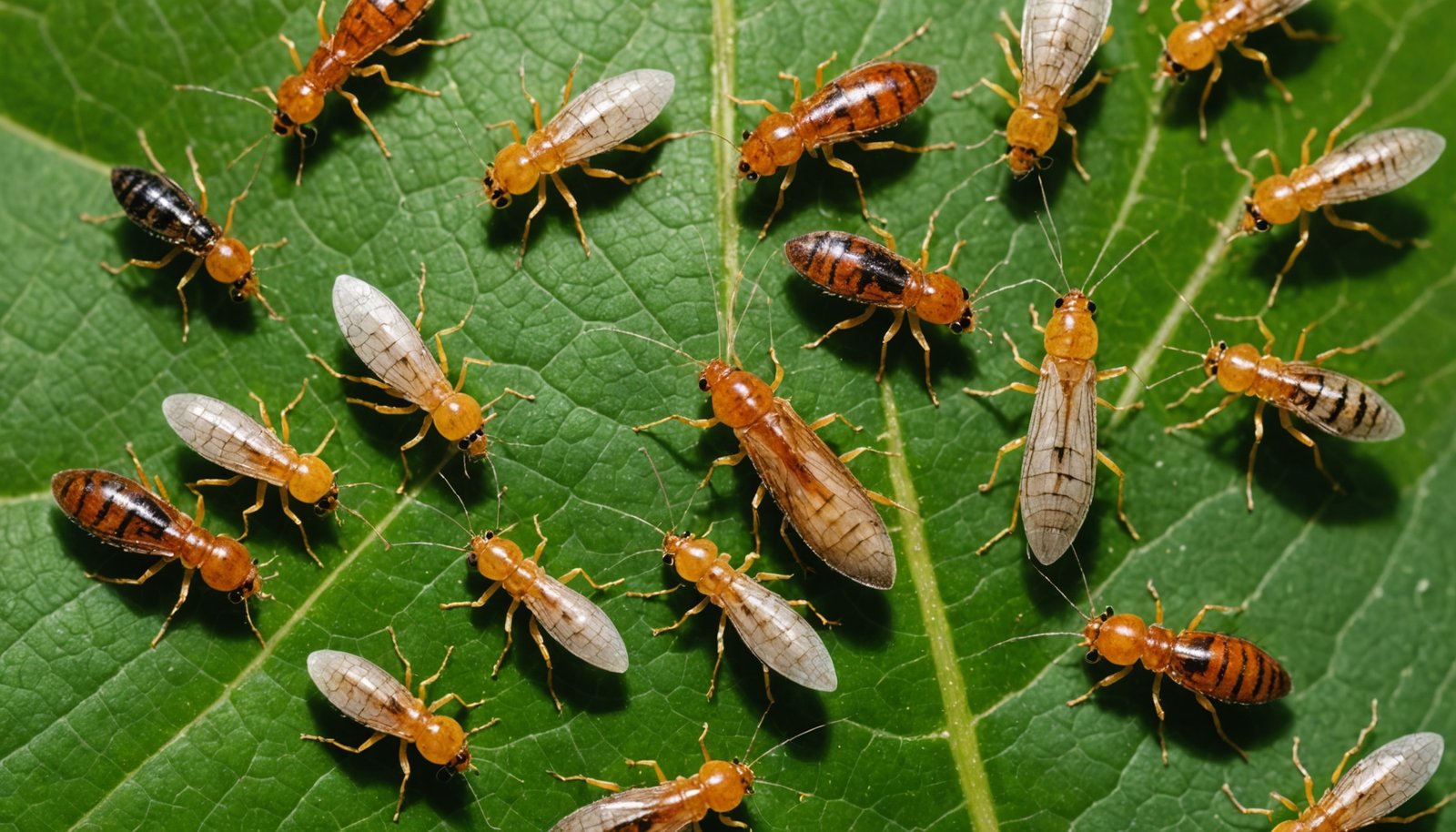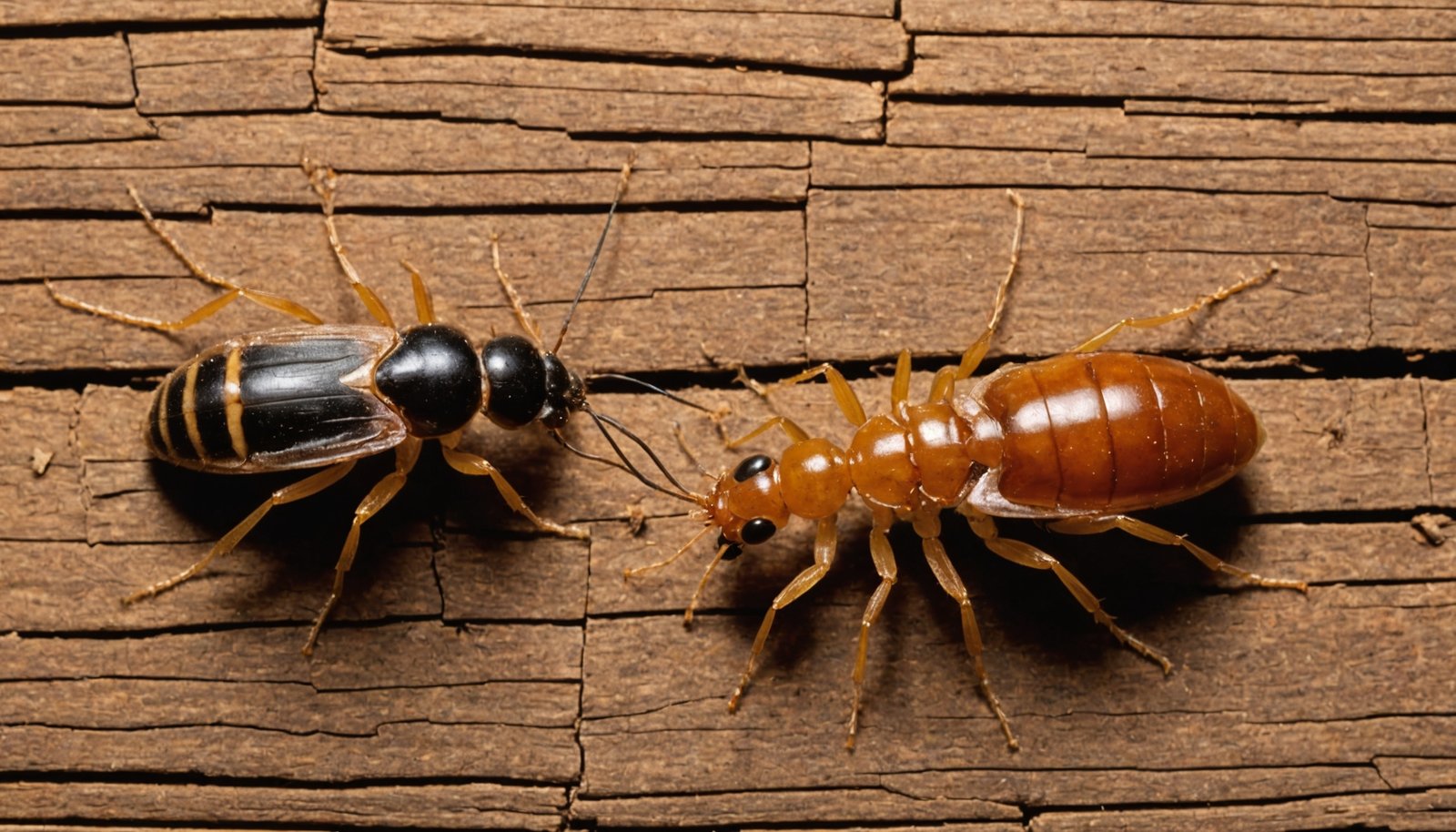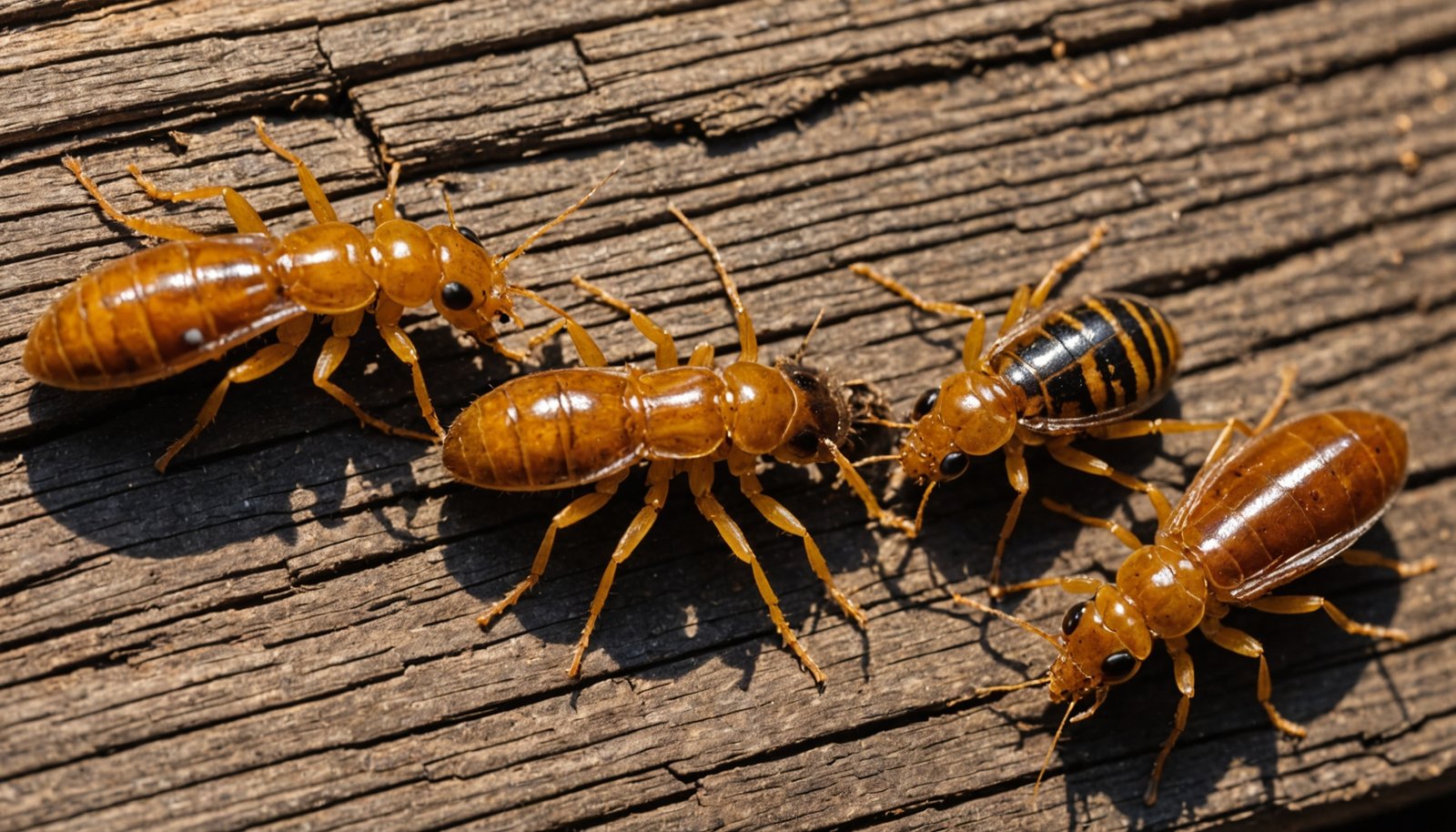Termite Identification Guide: Species, Signs & Key Differences
Spot termites fast by checking waist, antennae, and wings: termites have straight, thick waists, straight beaded antennae, and equal-length wings; ants are pinched with elbowed antennae and uneven wings. Match species to signs: subterranean (95% of U.S. damage) make mud tubes; drywood leave frass and kickout holes; dampwood favor wet, decayed wood; Formosan spread aggressively. Look for swarmers, shed wings, hollow-sounding wood. Warm, humid areas boost activity. Get the ID right to choose the best control and prevention methods—more ahead.
Key Takeaways
- Termites have straight, thick waists and straight, beaded antennae; ants have pinched waists and elbowed antennae.
- Termite wings are equal in length and extend past the body; ant wings are unequal in size.
- Subterranean termites build mud tubes from soil; drywood termites live entirely in dry wood and leave kickout holes with frass.
- Key signs: swarmers near windows, shed wings, pencil-width mud tubes, hollow-sounding wood, and pellet-like frass.
- Warm, humid climates favor termite activity; species and habitat determine control methods, with Formosan colonies especially challenging.
Termite Species at a Glance

Although termites share some traits, each major species leaves distinct clues.
You’ll most often encounter subterranean termites—the culprits behind about 95% of U.S. damage. They live in huge underground colonies, need soil contact, build muddy tubes to reach wood, and typically eat along the grain without kicking out debris.
Formosan termites hit hard in the South and Hawaii. These “super termites” form massive colonies, weave intricate mud nests in walls and soil, and chew through wood, plaster, plastic, and even thin metals. Once they’re in, they’re notoriously tough to control.
Drywood termites skip the soil. They nest inside dry wood—rafters, trim, and supports—and reveal themselves by tiny kickout holes that eject pellet-like feces. Colonies are smaller but spread by flights. In Texas, drywood termites are primarily found in coastal counties.
Dampwood termites favor moist, often outdoor wood. They’re larger, less likely indoors unless there’s chronic moisture, and occur along Pacific coasts, the Southwest’s arid zones, and southern Florida.
Conehead termites, primarily in Florida, spread fast and tunnel extensively.
Physical Traits to Tell Termites From Ants

Start by checking the waist: termites have a straight, thick waist, while ants show a pinched, hourglass shape.
Next, look at the antennae—termite antennae are straight and beaded, but ants’ are elbowed. Termites are usually lighter colored, often white or pale cream, while ants tend to be darker shades like red, black, or brown.
Finally, compare wing length: termite wings are equal and extend well past the body, while ants have larger front wings and shorter hind wings.
Waist Shape and Size
When you’re trying to tell termites from ants fast, focus on the waist. Termites have a broad, uniform midsection with no pinch between the thorax and abdomen, so their bodies look straight and tube-like.
Ants show a distinct, narrow “wasp waist” (petiole) that creates a segmented, hourglass profile. This single cue is one of the most reliable ways to separate the two at a glance.
Look for size, not just shape. Termite waists stay thick and consistent; ant waists thin sharply, making the middle visibly narrower. Termites thrive in damp, moist environments, often near water sources.
The difference holds even in winged swarmers: termites still present a broad waist, while ants keep the pinch. Termites’ soft, continuous body aids slow, wood-focused movement, while ants’ constricted waist supports flexible abdomen motion for foraging, defense, and stinging in some species.
Antennae Type Differences
If you can see the antennae, you can separate termites from ants in seconds. Termites carry straight, beaded (filiform) antennae that may droop slightly but never bend. Ants show a clear elbow: a sharp kink that creates an “L” shape. That bend, often near the middle, makes ant antennae look jointed and knobbly. Accurate pest identification is essential because misidentifying winged termites as ants can lead to ineffective control and costly callbacks.
Look at the segments. Termite antennae have many uniform, bead-like links, forming a smooth line. Ant antennae often vary in segment size, sometimes ending in a small club, which accentuates the elbow. These differences are usually visible without magnification, but good light helps.
Function tracks form: termites’ straight antennae suit tactile sensing in dark tunnels; ants’ elbowed antennae enable precise, multidirectional probing during foraging.
Quick rule: straight = termite; bent/elbowed = ant.
Wing Length Comparison
Two quick checks separate termite wings from ant wings.
First, look for equal length. Termites have four wings that match; both pairs are the same size and extend about 1/3 to 1/2 inch beyond the body. Ants show unequal pairs: the front wings are longer and pointed, the hind wings shorter.
Second, check the tips and texture. Termite wings are clear to pale, translucent, veined, and rounded at the ends; they’re fragile and shed easily, often piling up near windows and entry points. Ant wings are browner, sturdier, and less likely to be discarded. Observing multiple characteristics like wing length, antennae shape, and waist constriction together improves accuracy and prevents misidentification.
Use body-to-wing proportions, too. Termite swarmers’ long, equal wings look oversized. Flying ants—especially larger carpenter ants—have prominent front wings, but overall wing length usually doesn’t surpass the body as dramatically.
Key Differences Among Major Termite Types

Next, you’ll sort termites by what you can see, where they nest, and the risks they pose.
You’ll compare physical ID traits like body size, wing veins, and soldier head shape, then link those to nesting habits and feeding behavior.
Finally, you’ll note which species occur in your area and prioritize threats based on their colony size and destruction potential.
Physical ID Traits
Shape, size, and symmetry separate termite types at a glance. Start with antennae: termites have straight, bead-like segments, not elbowed like ants. Subterranean antennae segments look uniform; western drywood shows a particularly long third segment. Check heads and jaws: subterranean soldiers have dark, rectangular heads with strong mandibles; drywood soldiers’ heads are smaller; Indo‑Malaysian drywood shows a frontal ridge. Dampwood soldiers carry large reddish or flattened yellow‑brown heads with long, sharp mandibles.
Size and color help fast sorting. Dampwood can reach 1 inch and look robust; drywood run 1/4–3/8 inch with clear body segments; subterranean workers are smallest and pale. Swarmers’ wings come in equal pairs, shed after flights. Compare pellet shape to confirm species.
| Trait | Quick ID Cue |
|---|---|
| Head/Mandibles | Rectangular dark (subterranean); large reddish or flattened with long jaws (dampwood); smaller heads (drywood); ridge (Indo‑Malaysian drywood) |
| Antennae | Straight, beaded; uniform segments (subterranean); elongated third segment (western drywood) |
| Body Size/Shape | Dampwood largest, robust; drywood segmented; subterranean smallest workers |
| Wings | Two equal pairs extending past abdomen; drywood lighter wings; dampwood darker |
| Color/Frass | Dampwood reddish-brown; subterranean swarmers dark; drywood sand-like pellets; dampwood larger rounded pellets |
Nesting and Behavior
While all termites need moisture, where and how they get it separates the major groups.
Subterranean termites nest underground or in roots, staying in humid soil and traveling through mud tubes to reach wood.
Drywood termites live entirely inside dry timber or furniture, carving tight galleries that conserve moisture without soil contact.
Dampwood termites occupy wet, decayed wood above ground, favoring stumps, logs, and saturated structural components.
1) Nesting architecture: subterraneans build vast soil networks; drywoods form compact, internal galleries; dampwoods expand through soggy wood fibers.
2) Foraging routes: subterraneans bridge gaps with protective tubes; drywoods eat where they live; dampwoods move within moist wood.
3) Humidity control: soil contact vs. sealed galleries vs. waterlogged substrates.
4) Defense: strong-mandibled soldiers in many subterraneans; nasute soldiers deploy chemical sprays; rare autothysis blocks intruders.
Distribution and Risks
Even if you never see a swarm, termites’ distribution shapes your risk. You’re most exposed in tropical and subtropical cities where invasive subterranean species like Coptotermes formosanus and C. gestroi thrive. Human trade—especially wood products—moves them globally, while warming trends push ranges into temperate zones and cities with strong trade links. C. acinaciformis reaches cooler, drier coasts and interiors, widening risk beyond the tropics.
Minimum temperature limits natural spread, but urban heat islands and irrigated landscapes create pockets where multiple species coexist and compete. Formosan subterranean termites drive the highest global damage, while drywood species like Cryptotermes brevis hitchhike in furniture, seeding distant infestations. Early detection’s hard, so costs escalate quickly.
| Zone/Factor | Risk Snapshot |
|---|---|
| Tropical cities | Highest diversity/invasion |
| Subtropical ports | Rapid spread via trade |
| Temperate urban cores | Expanding risk with warming |
| Dry coastal belts | C. acinaciformis incursions |
| Furniture/wood flows | Drywood termite transport |
Common Signs of an Active Infestation
Although termites often stay hidden, you can spot an active infestation by watching for a few unmistakable clues. Look for swarmers (winged alates) inside or near windows, lights, or doors—especially in spring or after rain. Their shed, translucent wings on sills, decks, or caught in webs confirm a recent emergence. Remember, killing swarmers doesn’t remove the colony; it signals you need professional treatment.
Watch for swarmers and shed wings—clear signs of termites needing prompt professional treatment.
1) Swarmers and shed wings: Indoor swarmers often die if they can’t reach soil, indicating colonies within the structure. Piles of identical wings are a classic red flag.
2) Mud tubes: Pencil-width, dry, brown tunnels on foundations, crawl spaces, or beams show subterranean travel routes. Breaking a tube and seeing it repaired suggests active movement.
3) Wood damage and frass: Hollow-sounding or blistered wood, linear galleries (subterranean) or erratic galleries (drywood), plus carton-like deposits or pepper-like pellets.
4) Live termites and structural clues: Pale, soft-bodied insects, persistent droppings, swelling or sagging wood without leaks, and soft spots indicate ongoing feeding.
Where Termites Live and Thrive
Because termites evolved to exploit cellulose and moisture, they thrive where warmth, humidity, and shelter converge. You’ll find peak activity in the South, Southeast, West, and Southwest, where mild winters and high humidity keep colonies stable. Their soft bodies lose water fast, so they avoid sun and airflow, staying hidden in soil, wood, or protective structures while feeding on cellulose in lumber, plants, and debris.
Subterranean termites live in soil, tunneling to reach water and wood. They build mud tubes to cross exposed areas, guarding against drying and ants. They gravitate to leaky plumbing, condensation, poor drainage, scrap lumber, and poorly ventilated crawl spaces.
Drywood termites nest entirely inside dry wood, from furniture to framing, never needing soil or mud tubes.
Dampwood termites occupy saturated or rotting wood in wet or forested sites.
Across ecosystems, termites decompose plant material, enrich soils, and, in savannas, raise towering mounds that aerate soil, boost nutrients, and shape habitat for other species.
Why Accurate ID Matters for Treatment
When you identify termites accurately and early, you stop hidden damage before it snowballs. Termites work out of sight in walls and wood, so precise ID lets you target the species, curb structural risks, and avoid runaway repair costs.
Pros use infrared, moisture meters, and acoustic tools to expose activity and map it, so treatments hit colonies—not just surface signs like frass or mud tubes.
Pros use infrared, moisture, and acoustic tools to reveal hidden termite activity and target colonies directly.
Here’s why accuracy drives better outcomes:
- Species-specific tactics: Subterranean, drywood, and Formosan termites require different control methods, from soil barriers to wood injections and baiting. Proper ID shortens eradication time and cuts chemical use.
- Cost control: Early, correct methods prevent expensive remediation. Missteps with DIY sprays often leave colonies intact and lead to repeat visits.
- Tool precision: Knowing the species guides which detectors to deploy and where, improving inspection confidence and targeting.
- Long-term prevention: Species insights shape moisture management, wood treatments, materials choices, and monitoring, reducing future risk.
Conclusion
You’ve now got the essentials to spot termites fast, tell them from ants, and recognize the species that’s chewing through your place. Use the physical clues, habitat cues, and activity signs to confirm what you’re dealing with. Act quickly—accurate ID drives the right treatment, prevents costly damage, and protects your home long-term. If you’re unsure, collect samples or photos and call a licensed pro. You’ll save time, money, and headaches by getting it right the first time.

